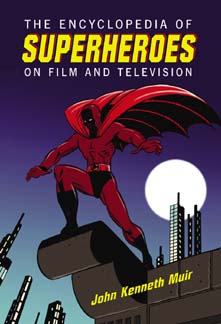|
July 2005
Bad Times Make Good Movies
Media Commentary By John Kenneth Muir
 Turbulent times make for interesting films. I’ve written extensively on this thesis many times and in many places, in books such as Horror Films of the 1970s and The Encyclopedia of Superheroes on Film and Television. Enmeshed in a never ending “War on Terror,” many of America’s Regular Joes are today beginning to feel uneasy about national matters, from the Right’s assault on Social Security and the Federal Judiciary to the ever-deepening national deficit deepened by a party that once prided itself on fiscal responsibility but now only wants more tax cuts for the rich.. Naturally—as the summer of 2005 proves so dramatically—our movies, our mainstream entertainment, are beginning to reflect these fears. And virtually all at once, too.
Turbulent times make for interesting films. I’ve written extensively on this thesis many times and in many places, in books such as Horror Films of the 1970s and The Encyclopedia of Superheroes on Film and Television. Enmeshed in a never ending “War on Terror,” many of America’s Regular Joes are today beginning to feel uneasy about national matters, from the Right’s assault on Social Security and the Federal Judiciary to the ever-deepening national deficit deepened by a party that once prided itself on fiscal responsibility but now only wants more tax cuts for the rich.. Naturally—as the summer of 2005 proves so dramatically—our movies, our mainstream entertainment, are beginning to reflect these fears. And virtually all at once, too.
At the end of May, Star Wars Episode III: Revenge of the Sith opened to outstanding reviews and blockbuster ticket sales. The film’s subject is the final death throes of a noble Republic as it quietly transforms itself into an Empire. Sound familiar? As the Emperor (Ian McDiarmid) gives his victory speech, heralding this catastrophic transformation from democracy to tyranny, he exploits the idea of “security” as his primary rationale for curtailing personal rights. “So this is how democracy dies,” groans Senator Amidala (Natalie Portman), to “thunderous applause.” The Emperor has manipulated fear (the bailiwick of the Dark Side), to scare people into giving away their liberty. This moment recalls President Bush’s 2002 State of the Union Address, and his unveiling of the Bush Doctrine, a strategy that permits us to attack other nations if we fear they will attack us. It also brings to mind the Patriot Act, signed in the days after 9/11; a document not even read by the vast majority of those in Congress who approved its passage. Fear, George Lucas seems to be telling us, makes us act irrationally.
Hammering home the analogy to Twenty-First Century America, Star Wars’ protagonist (and antagonist...) Anakin Skywalker (Hayden Christensen) even quotes a variation of George W. Bush’s famous 2002 ultimatum to foreign countries harboring terrorists: “You’re either with us or you’re against us.” Ben Kenobi’s wise response? “Only a Sith thinks in absolutes.”
On June 15th, Hollywood released Batman Begins, a re-boot of the Caped Crusader franchise, dormant since 1997. This film by Christopher Nolan highlights a Gotham City in dire straits following a Second Great Depression. The city’s leaders are corrupt, out only to line their pockets and remain in power. At a time when many economists are predicting a 'burst' in the so-called housing bubble, House Republican Leadership under Tom Delay is tainted by serious allegations of impropriety, and Halliburton keeps winning no-bid contracts (and in the eyes of some, allegedly committing crimes of war profiteering...), these points seem especially noteworthy. Notice too how the Scarecrow’s evil strategy involves a bio-terror attack on the urban water supply, a strategy that hardly seems implausible (let alone fantastic) in these days of color-coded terror threats, shoe bombers and the like. Americans are individualists who have always craved super heroes, those loners who ride in to save the day, and a Batman-like figure who will swoop in and clean house has never seemed more attractive, appealing—or necessary—than in today’s poisonous political climate of corruption and greed.
Last week, on June 24th, George A. Romero’s Land of the Dead opened. This is the fourth installment in the director’s celebrated 'living dead' series, and like every one of its predecessors, reflects and comments on its time. Many scholars and critics viewed 1968's Night of the Living Dead as a metaphor for the Vietnam War, with the walking dead representing our dead soldiers, come back from the grave. In 1979, Dawn of the Dead was set in a shopping mall, and reflected the rampant commercialism and consumerism taking hold of the culture as the 1980s dawned. Day of the Dead , released in 1985, was a subtle examination of explosive racial and sexual politics. The lead character, a female scientist named Sarah (Lori Cardille) even declared—in prescient fashion—a variation of Rodney King’s famous quote from the early 1990s: “Can’t we all get along?” Considering this backdrop, it is no surprise that Land of the Dead deals cogently with the dreads and social context of our age.
Land of the Dead concerns the (mostly white) inhabitants of Fiddler’s Green—a luxury high rise in the middle of Pittsburgh—as they wine, dine and shop. But just meters away, many poor people live in squalor in the city beyond. Outside the city walls, things are even more gloomy: the flesh-eating zombies roam in huge numbers, yet mostly seem to mind their own business. In fact, the opening of Land of the Dead reveals the zombies living in a fragile state of peace. Many dwell in a small town called Unionville, where a zombie band attempts to play in a gazebo (!), and a young zombie couple strolls in a park. Then the raiders from Fiddler’s Green—the mercenaries—arrive. These men and women want Unionville’s resources and supplies, and start shooting up the place and blowing away the zombies. The unprovoked actions of the mercenaries inflame one smart zombie, Big Daddy, who forms a militia and takes the war right back to Fiddler’s Green, thus destroying the delicate balance of peace both sides have lived with since the zombie plague.
In toto, this is a perfect metaphor for President Bush’s ever-more-costly misadventure in Iraq. Before America invaded and occupied that land, the country was inhabited by some truly rotten (though not rotting...) people like Saddam Hussein, yet the country was not actively a threat to our peace. Iraq had no transcontinental weapons that could deliver death to America, no connection to the terrorist attacks on 9/11, and no WMD. But Iraq certainly had resources we could use (those vast oil fields...), and in we charged. Today President Bush claims Iraq is a central front in the War of Terror. Well, he’s right! Our long-term occupation of Iraq has indeed inflamed many Islamic fundamentalists in the Middle East. Just how many revolutionaries like Big Daddy have our actions there created? And when will these new Al Sadrs or Zarqawi’s be suicide bombing our streets?
Land of the Dead actually deals with a number of topics relevant to this era.. The humans of Fiddler’s Green torture the zombies brutally, using them for target practice. These images immediately bring to mind the photos from Abu Graibh, but more important to the whole metaphor is the representation of Fiddler’s Green as a microcosm for America.. We live like kings here while outside many citizens of the globe live in poverty . Yet we consume 25% of the world’s resources. Still, we try not to look beyond our 'gleaming high rise.' It’s easier to ignore problems, whether it be a zombie apocalypse or global warming. Remember George W. Bush’s call to Americans in the days after 9/11? It wasn’t a noble plea for conservation or sacrifice. It was, instead, a call to 'go shopping!'
Following Land of the Dead is Steven Spielberg’s War of the Worlds, which opened June 29th. This film takes us right back to the dominant metaphor of our age, September 11, 2001. Here, 'sleeper' cylinders rise up from the ground, release alien killing machines in the heart of our cities, and destroy us from within. American citizens are reduced to ash. The missing are sought desperately on bulletin boards. Debris falls from the sky like rain. These images reflect the palpable fear—still alive within all Americans—that we are as vulnerable to attack now as we were on that terrible autumn morning four years ago. Terror might come again and take away our loved ones. (After all, it seems Osama Bin Forgotten...)
The national mood of America today is undeniably sour, a malaise, and—make no mistake—the Bush Administration is in deep, deep trouble. This summer’s entertainment proves that fact succinctly. Four mainstream, blockbuster films released in about one month’s time all take direct aim at our country’s leadership. The mainstream media may be asleep (or slowly—oh so slowly —awaking), but as always, artists have picked up on the mood and are mirroring it. When pundits on television worry about the reasons behind the President’s sinking poll numbers, they need only to look at movie theater marquees.
President Bush may want us to 'stay the course.' Perpetually. But artists such as George Lucas, Christopher Nolan, George A. Romero, and Steven Spielberg are reminding American moviegoers what many of us already realize: his leadership has taken us off course.
|




